
September-October 2015 Advancement News 1
Previous issues are available at www.scoung.org/scoutsource/BoyScouts/AdvancementandAwards/advancement_news.aspx
Opportunities for Advancement Administrators
Florida Sea Base —Advancement Treasure Hunt
Mechanics of Advancement: January 10-16, 2016
Ahoy, Scouters! Are you struggling with understanding how advancement should
work, how to help youth succeed, or how to assist units to achieve proper and eec-
ve advancement? The answers to these golden quesons—and so many others, such
as “Does it snow in the Keys in the winter?”—are just waing to be discovered at the
Florida Sea Base Conference Center this coming January.
The Mechanics of Advancement curriculum that will be
presented January 10-16, is for all advancement person-
nel, but is parcularly directed at those who are new to
advancement or are in need of some refreshing. The goal
of this conference-style course is to create an advance-
ment environment in districts and councils that will in-
crease their rates of advancement and retenon through
proper advancement administraon.
Connued on page 2
Advancement News
Advancement News
September-October
2015
Vol. 5, No. 5
Opportunies for Advancement Administrators: Florida
Sea Base—Advancement Treasure Hunt; Report from
Philmont Training Center: Conference Highlights
On Increasing Advancement: Boy Scout Requirements
Changes Begin January 1, 2016; What’s Changing?
The Cub Scout Angle: A Cub Scout’s Adventure—It Sll
Begins with Bobcat
Eagle Issues: Avoiding Appeals and Extensions
Merit Badges - Enhancing Our Youth’s Compeve
Edge: Using the New Digital Merit Badge Pamphlets;
Best Pracces for Approving Merit Badge Counselors;
Using Web-based Tools in Merit Badge Instrucon
From the Field: A Tesmonial—Training Opportunies
Make a Big Dierence; Don’t Miss Out on These Great
Training Opportunies in 2016!
From the Archives: The Cub Scout Angle: The Inverted
Percentage (October 2011)
A Peek Ahead: What Is Planned for November-
December
Helpful Links
In This Issue
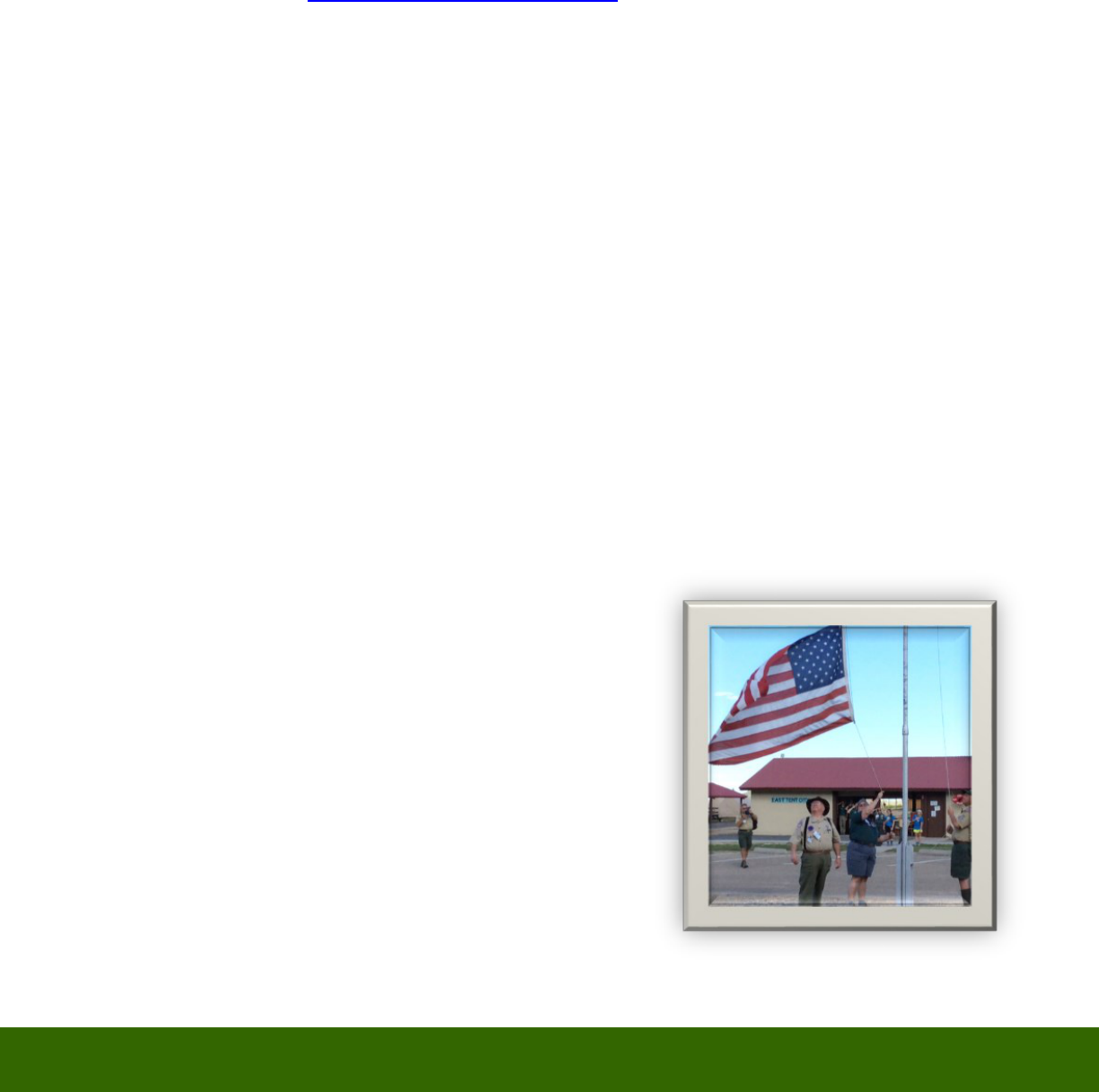
September-October 2015 Advancement News 2
Connued from page 1
Every signicant aspect of advancement, from Cub Scouts to Sea Scouts, lies “buried” in the curriculum,
which will be presented by members of the Naonal Advancement Commiee and Naonal Advancement
Advisory Panel, who can be expected to bring more “treasures” from their own experiences, as well as the
very latest updates on advancement issues and trends.
So, what are you waing for? Make plans now to aend this fun and excing opportunity. Informaon about
the conference center, which also will be oering a very excing spouse program during the week of January
10-16, 2016, is available at www.bsaseabase.org/seabase.aspx. Don’t miss this chance to dig for advance-
ment treasures in the Florida Keys in January!
Report from Philmont Training Center, June 7-13, 2015:
CEAA Highlights
In the July-August edion, Advancement News shared photos of the Conference on Educaon for Advance-
ment Administrators (CEAA) held in June at the Philmont Training Center. The “rest of the story” is now in,
and it conrms those early reports: the CEAA was a huge success!
While the conference’s parcipants immersed themselves in serious discussions about many aspects of ad-
vancement, there were some addional highlights noted by aendees. On Monday evening and Tuesday
morning, CEAA aendees conducted the training center’s ag ceremonies, seng the standard for the other
conferences for the remainder of the week. On Tuesday, the Naonal Venturing President addressed all con-
ference aendees and answered quesons. On Thursday morning, CEAA welcomed instructors from other
conferences who provided updates on their areas of experse. On Thursday aernoon, CEAA took a eld trip
to the Rocky Mountain Scout Camp to be inspired by a beauful part of the ranch.
All parcipants indicated that they were likely to recommend this conference to others once they returned
home. A sampling of responses includes:
“The advancement course at PTC was informave and upli-
ing. I came away feeling so much more prepared to fulll
my posion to help more youth succeed.”
“I totally enjoyed my experience at the PTC. The advance-
ment training was very informave and the sta was very
supporve. I will denitely let others know that this is a
worthwhile use of their me.”
“I can’t believe I waited so long to make it to Philmont!!! It
was great to be able to contribute to naonal projects
while at the same me learning so much.”
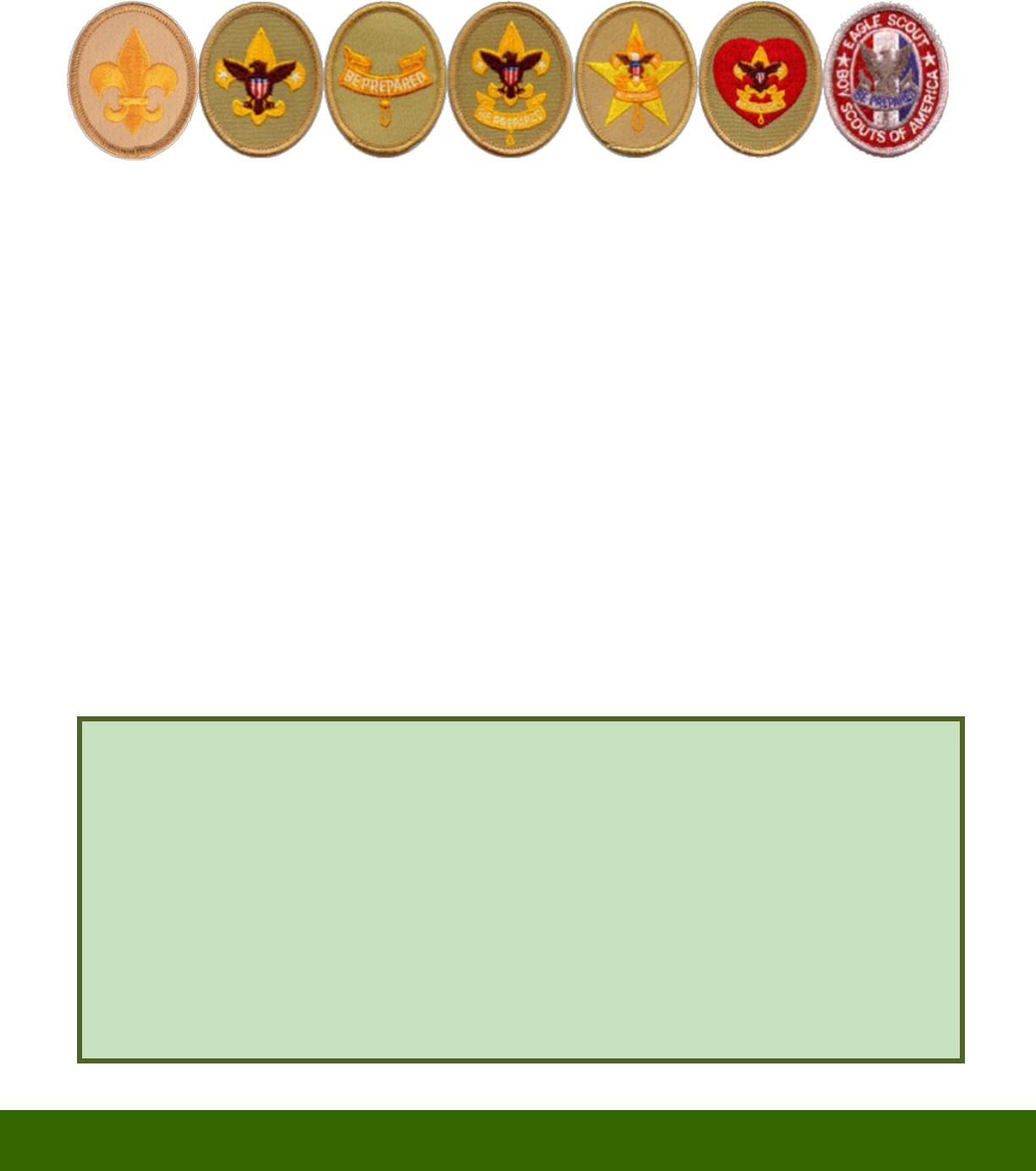
September-October 2015 Advancement News 3
On Increasing Advancement
Boy Scout Rank Requirement Changes Begin January 1, 2016
With all the recent “buzz” about the new Cub Scout rank changes, some may have missed that at the begin-
ning of next year, Boy Scout rank requirements will also undergo changes.
What’s Changing?
Scout Badge Becomes Scout Rank
Beginning January 1, 2016, Scout becomes a rank and is no longer considered just a “joining badge.” As with
all other ranks, each requirement now must be completed as a member of a Boy Scout troop. The Scoutmas-
ter or designated leader must sign o each individual requirement as the boy demonstrates his knowledge
or skill. There is no board of review for Scout rank— the Scoutmaster conference is considered sucient
adult interacon at this introductory rank.
Service : The Scout Oath in Acon
In keeping with the Scout Oath and “helping other people at all mes,” service is now a requirement at each
Boy Scout rank except for Scout rank – one hour at Tenderfoot, two hours at Second Class, and three hours
at First Class. The total hours for Star and Life remain the same at six hours each. But half of the hours for
Life rank must now be conservaon-related, emphasizing the importance of stewardship of the earth.
Connued on page 4
When/Who?
The new Boy Scout rank requirements become eecve on January 1, 2016, subject to these transion
guidelines:
Boys registered in a troop on or prior to December 31, 2015, who are working on Tenderfoot through First Class may
connue to work using the old requirements through 2016, but they must convert to the new requirements upon
aaining First Class.
Boys registered in a troop, team, crew, or ship, who have completed First Class rank on or prior to December 31, 2015,
may complete the rank they are currently working on with the old requirements through 2016, but then must convert
to the new requirements for subsequent ranks.
Any boy registering in a troop for the rst me on or aer January 1, 2016, must use the new requirements.
Beginning January 1, 2017, new requirements must be used for all ranks earned.
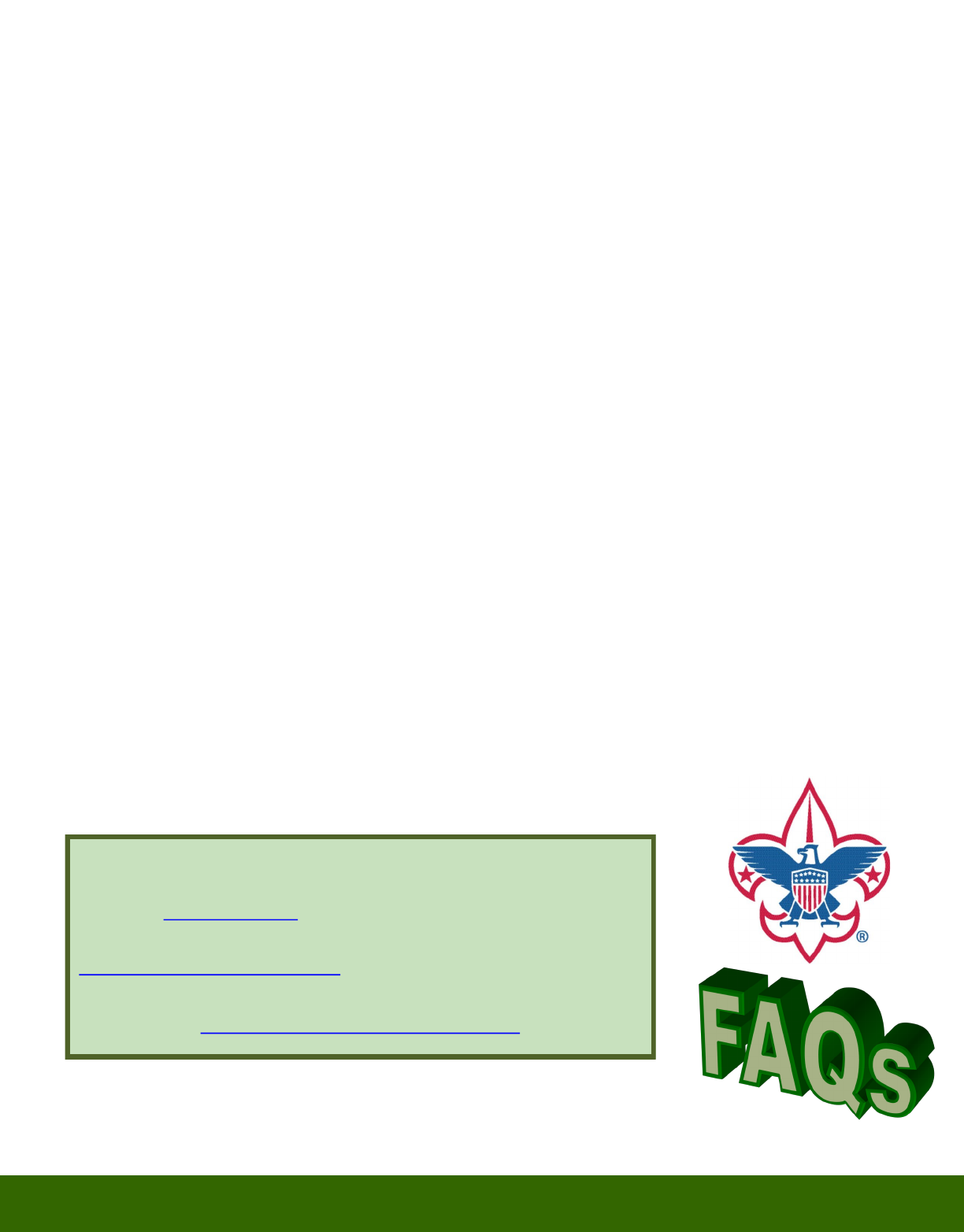
September-October 2015 Advancement News 4
Connued from page 3
Scout Spirit and Duty to God: It’s a Monologue, Not a Dialogue
Scout spirit requirements are not meant to require a discussion or a two-way conversaon about duty to
God. The boy is simply to “tell” how he believes he has done his duty to God as dened by him and his
family. The troop leader’s role is to listen. The intent is for the Scout to have a self-reecon about belief
and reverence, for expression by the Scout to his leader.
Physical Fitness: Developing Lifelong Habits
New requirements in Tenderfoot through First Class ranks are designed to encourage physical acvity as a
lifelong habit. Boys are challenged to set goals and work toward achieving them. This might include addi-
onal exercise or incorporang requirements for earning merit badges that encourage physical acvity.
Troop programs can make tness acvies a regular part of their program plan—which could lead to even
higher goals, such as the SCOUTStrong program or the Presidenal Acve Lifestyle Award (PALA).
Camping: Learning in the Great Outdoors
Although the number of troop or patrol acvies remains the same (10 total for First Class), the number
of campouts required has doubled – one for Tenderfoot, two more for Second Class, and three more for
First Class – for a total of six campouts. This increase will help ensure that First Class Scouts have sucient
camping experience to have developed and improved upon the outdoor skills that Scoung promotes.
Navigaon: Using Handheld GPS Units
Some navigaon requirements allow the opon of using a handheld GPS unit, GPS app on a smartphone,
or other electronic navigaon system. Map and compass requirements are sll included as Scouts should
“be prepared” for situaons where electronic systems are not available. However, Scoung wants to
train Scouts to use their resources, including electronic ones, safely and appropriately.
Program Updates Web Page
Watch the Program Updates web page for “Frequently Asked Quesons”
about the new Boy Scout requirements. Submit your own quesons at
advancement.team@scoung.org. The FAQs will be updated periodically
as new quesons arrive.
www.scoung.org/programupdates

September-October 2015 Advancement News 5
About
Advancement News
Follow the Naonal Advancement Team on Twier! BSA Advancement Team, @AdvBSA
Advancement News is the ocial e-leer of the Boy Scouts of America Naonal Advancement Team and the Naonal Ad-
vancement Commiee. Its intent is to provide and clarify procedures found in the Guide to Advancement, announce various
changes and updates in advancement, and to assist advancement commiees in making decisions that can help increase the
rate of advancement. Therefore, districts and councils may reprint arcles from this publicaon. Our plan is to distribute six
issues of Advancement News annually, but special edions may go out whenever there is important informaon to share.
Feedback, suggesons, and leers to the editor are welcome at advancement.team@scoung.org.
The Cub Scout Angle
A Cub Scout’s Adventure—It Still Begins With Bobcat
The new Cub Scout advancement program includes many excing new adventures and
many related advancement requirements, but one thing has not changed, even if the
requirements have—a boy’s personal adventure starts by earning the Bobcat badge.
Cub Scouts now use the Scout Oath and Scout Law. The rst two Bobcat requirements are
1. Learn and say the Scout Oath, with help if needed.
2. Learn and say the Scout Law, with help if needed.
Note that each of these requirements ends with the phrase “with help if need-
ed.” Remember the Cub Scout moo is sll “Do Your Best.” This means that it is
allowable to coach a boy as he recites the Scout Oath and the Scout Law. Com-
pleng these two requirements should be an inving, fun experience. This is the
start of the youth’s Scoung journey. Understanding and perfecon will come
with me. The new Cub Scout will recite the Scout Oath and Scout Law hun-
dreds, if not thousands, of mes before he hopefully one day recites them at his
Eagle Scout court of honor.
By making this rst Bobcat requirement a me of welcoming for our new Cub
Scout, “with help if needed,” let us make sure we begin his Scoung journey
with the joy of accomplishment not the stress of perfect performance. Our pur-
pose is to insll the ideals of Scoung embodied in the Oath and Law so that
they become a lifeme character beacon for our young Cub Scout. In this way
we will get the opportunity over me to inuence the character of the boy so
that the man will embody the Oath and Law as a part of his life. Now, isn’t that
what we’re all about?

September-October 2015 Advancement News 6
Eagle Issues
Avoiding Appeals and Extensions
While processes are in place for subming Eagle Scout rank appeals and me exten-
sions, it is always best to avoid these situaons, whenever possible.
In the past, appeals oen resulted from a Scoutmaster’s refusal to grant a unit leader
conference or to sign the Eagle Scout Rank Applicaon. Others occurred when the unit
or the project beneciary refused to sign nal approval for the Eagle Scout service project. Fortunately, ap-
peals for these reasons have sharply declined since the publicaon of the Guide to Advancement in 2011,
and, with subsequent updates of the GTA, have become increasingly rare.
Not so rare are appeals where a Scout is denied advancement at his Eagle Scout board of review. In some
cases, the denial is warranted; in others, it is not. The best way to ensure the appropriate decision is
reached is to educate board members on proper board of review procedures, as explained in GTA, Secon
8. This instrucon may help avoid situaons leading to appeals--such as contenons that board members
did not follow proper procedures or that boards denied advancement for reasons not directly related to
rank requirements.
The best way to avoid extension requests is to communicate regularly with the youth and develop with him
a meline for compleng remaining requirements. Some Scouts may sll, however, nd themselves unable
to complete all requirements before their 18th birthdays. Unexpected circumstances (such as sickness, inju-
ry, or family crisis) may arise. Or already recognized circumstances might be aggravated by other issues to
the point where the Scout may not be able to complete all requirements in me.
Each case should be examined on its own merits. Before proceeding with an extension request, consider
carefully the provisions of GTA topic 9.0.4.0, which explains the criteria for evaluang a request. For exam-
ple, a request might cite “adult error” as the reason why an extension is necessary. In cases where this
translates into "Nobody told me" or "I didn't know," the BSA assumes that any Scout working on Eagle rank
has a Boy Scout Handbook and has read and understands the requirements.
In summary, the best way to help a Scout to
avoid these situaons is for involved adults to
read the Guide to Advancement, subscribe to
Advancement News, aend training and
roundtables, and keep up-to-date on ad-
vancement requirements—aer which they
should make sure that they and every Scout
with whom they are involved carefully read
the Boy Scout Handbook.
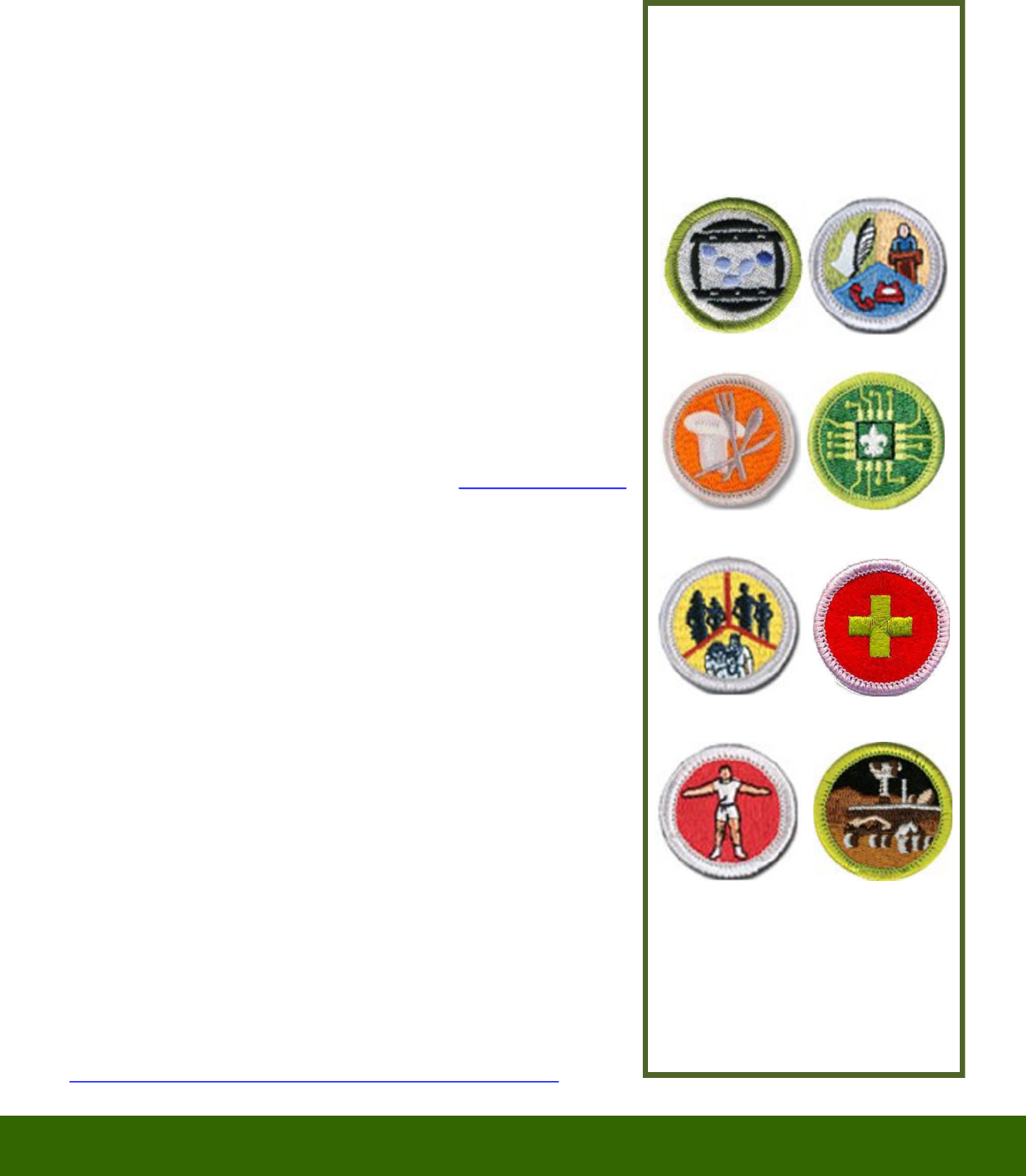
September-October 2015 Advancement News 7
Merit Badges: Enhancing Our Youth’s Competitive Edge
Usin g the New Digital Merit Badge Pamphlets
New digital merit badge pamphlets promise to put advancement at a
Scout’s ngerps with a mere keystroke. With innovaon comes the
concern that Scouts will lose the “hands on” experience that most
merit badges oer. Since this new technology will soon become an
opon for some merit badges, we need to be aware of the guidelines
for its use in order to beer counsel our Scouts as they work on merit
badges.
The introducon of this new format will be gradual. Expect to see
the Eagle-required merit badge pamphlets to appear rst in digi-
tal format, accompanied by a few oponal ones, such as Photog-
raphy, Animaon, and Robocs.
Digitally formaed pamphlets will not replace the tradional
ones, but will be available in addion to the printed copy current-
ly sold at your local Scout service center or trading post. Merit
badge pamphlets in both print and digital formats will be availa-
ble through the BSA Naonal Supply Group (www.scoutstu.org).
Digitally formaed pamphlets, while including all of the infor-
maon found in the printed versions, will also incorporate videos,
links to related websites, interacve acvies, and many other
subject maer-related enhancements not available in the stand-
ard merit badge pamphlet.
All merit badge requirements are wrien—and will connue to
be wrien—so they can be completed using only the material
contained in the printed pamphlet. Any resource, link, or en-
hancement found in a digital pamphlet—or used in conjuncon
with a printed pamphlet, for that maer—should be considered
“bonus” material, and as such, cannot be required viewing for any
Scout. While the merit badge experience is enriched by oering
these digital resources, counselors cannot add any addional re-
quirements or “homework” because of its availability. Although
most of our Scouts have moved into the digital-electronic era in
school, not all Scouts have availability to “smart” phones and de-
vices, or even access to the Internet, at home.
So click away. To nd more informaon or order digital merit badges:
www.scoutstu.org/bsa/literature-media/interacve-digital.html.
Which merit
badges are currently
available in the
digital format?
The remaining Eagle-required merit
badges are expected to be availa-
ble later in 2015.
Robocs Personal Fitness
Animaon
First Aid Family Life
Digital Technology
Communicaon
Cooking
Robocs Personal Fitness

September-October 2015 Advancement News 8
Are requests to become merit badge counselors automacally approved?
One of the responsibilies of the council advancement commiee is to “see to an eecve merit badge pro-
gram administered at either council or district level that funcons according to naonal procedures and re-
cruits, approves, trains, and makes known sucient counselors to meet the needs of the council” (GTA,
3.0.0.1, #11). So not everyone who applies to counsel a specic merit badge is necessarily approved.
For starters, all merit badge counselors must meet the basic qualicaons (GTA, 7.0.1.1):
Be at least 18 years old and of good character.
Be registered with the Boy Scouts of America (posion code 42).
Complete Youth Protecon Training.
Be recognized as having the skills and educaon in the merit badge subjects covered and hold any
required qualicaons and training as outlined in the Guide to Safe Scoung or the Guide to Advance-
ment—or use others so qualied.
Be able to work with Scout-age boys.
Complete a Merit Badge Counselor Informaon form (www.scoung.org/lestore/pdf/34405.pdf).
The intent of the merit badge program is for Scouts to learn from those with an appropriate level of exper-
se. Everyone who applies may have good intenons, but do they actually possess the appropriate level of
experse?
In its role of approving merit badge counselors, the council advancement commiee has the authority to de-
cide what constutes an appropriate level of experse, and even to establish a higher minimum level of skills
and educaon for any given merit badge (GTA, 7.0.1.1). For example, a council might
During the 2015 CEAA at Philmont, parcipants discussed “Best Pracces” for various advancement topics.
We now share the thoughts of those experienced Scouters with the hope that their eorts will be helpful to
your councils or districts.
Managing Subscriptions to
Advancement News
Advancement News is designed for council and district advancement commiees, advancement sta advisors, and Eagle pro-
cessors. However, any Scoung volunteer or professional may subscribe.
Subscribing. Send a message to advancement.team@scoung.org, with “SUBSCRIBE” in the subject line. Indicate your name,
email address, and council in the message text.
Unsubscribing. To decline future issues please reply and enter “REMOVE” in the subject line. We will remove the subscripon
within the next two weeks.
Receiving Mulple Copies. If you receive Advancement News at more than one email address, choose the one to be removed
and reply with “REMOVE” in the subject line. Include a message requesng that we remove only that email address.
Duplicate Copies. If you receive more than one coy of Advancement News at the same email address, please reply to all but
one of them with “DUPLICATE” in the subject line.
Address Change. If you want Advancement News sent to a dierent address, reply and enter “ADDRESS CHANGE” in the sub-
ject line. In your message, enter your council name and the email address you prefer.
Connued on page 9
Best Practices: Approving Merit Badge Counselors

September-October 2015 Advancement News 9
require that a counselor for the Animal Science or Pets merit badge be a veterinarian.
Councils have authority to restrict the number of merit badges that an individual is approved to counsel
(GTA, 7.0.1.4 ). This could result in an individual being denied when applying to counsel addional merit
badges.
How does a council go about approving an individual as a merit badge counselor?
The process begins with the individual subming a BSA adult applicaon with posion code 42. This appli-
caon must be submied even if the individual is registered in another BSA posion. A Merit Badge Counse-
lor Informaon Form (No. 34405, www.scoung.org/advancement) should be aached to the applicaon,
indicang the individual’s interests and qualicaons supporng the request.
The council advancement commiee is responsible for reviewing merit badge counselor applicaons for
both basic qualicaons and experse. An understanding should be established between the council ad-
vancement commiee and council registrar on the handling of merit badge counselor applicaons and how
the district or council will be noed. A mutually agreed upon process will help ensure that individuals are
approved prior to being ocially entered into ScoutNet.
The applicaon review process may be delegated to an individual or a group of individuals at either the
council or district level. Reviewers must understand the requirements of the merit badge being considered,
including any required training or cercaons (GTA, 7.0.1.0). Upon approval, the applicaon package is re-
turned to the council service center for background check and BSA registraon entry. A procedure for track-
ing cercaons and nocaon of expired cercaons should also be instuted. Establish a method to
nofy the individual of the decision, whether approved or not.
Connued from page 8
Using Web-based Tools in Merit Badge Instruction
In recent years, Scoung has experienced an increased presence of online merit badge courses. While the
wonders of today’s technology can make this an appealing method to many Scouts, care must be taken to
ensure the integrity of the merit badge process.
These web-based resources can be helpful when there is no local subject maer experse available, liming
a Scout’s ability to earn a merit badge that interests him. However, digital instrucon, including online
workshops, should never constute a Scout’s primary merit badge experience. Instead, under the guidance
of a qualied merit badge counselor, digital experiences should enhance or broaden his merit badge experi-
ence.
As with any type of merit badge group instrucon, the guidelines presented in Guide to Advancement, topic
7.0.3.2, must be followed. Specic procedures for using Web-based tools in advancement are established
by the council advancement commiee in compliance with naonal procedures (GTA, 3.0.0.1, #15). Some
examples of acons a council might consider:
Connued on page 10

September-October 2015 Advancement News 10
Connued from page 9
Merit badge instrucon is not to be confused with merit badge counseling. When employing web-
based technology, instrucon should be followed up by a counseling session during which the Scout
interacts face-to-face with a merit badge counselor to demonstrate his knowledge or skills. In many
situaons, both roles can be fullled by the same person, but it is dicult for the interacon to be suc-
cessful when it’s aempted in the same session.
Counselors oering web-based instrucon are approved by the council from which the instrucon
originates. Establish procedures for approving and monitoring merit badge counselors in your council
who oer their services online. If a counselor is operang from another council, determine how to
conrm with registraon in the home council, as well as approval for the merit badges they counsel
(GTA, 5.0.8.0).
Create a council list of merit badges appropriate for web-based instrucon.
Develop and conduct training at the council level for anyone hosng an online class to assure stand-
ardizaon and quality control, as well as compliance to BSA youth protecons and social media guide-
lines. (GTA, 5.0.8.0)
Set limits on the class size of web-based sessions. Patrol-size is oen best. Avoid conducng large ses-
sions that can inhibit the ability of the instructor to interact with Scouts.
Produce guidelines for technology- or Web-based merit badge instrucon that places the actual
tesng in a personal seng (GTA, 5.0.8.0). Use of workbooks is not to be required in lieu of personal
interacon (GTA, 7.0.4.8).
Any fee charged should be limited to recovering the costs related to presenng the opportunity (GTA,
7.0.4.10).
The preferred merit badge experience is direct, face-to-face interacon that takes place between a
Scout and his merit badge counselor, whose adult example is one of the key methods of Scoung. The
use of digital instrucon, interacve or not, should be the excepon, not the rule, in a Scout’s advance-
ment journey. Online courses should be limited and monitored to ensure that web-based instrucon
does not become an easy way for Scouts to complete the greatest number of merit badges.
In all aspects of technology-based advancement, both adults and youth must
adhere to BSA Youth Protecon guidelines (www.scoung.org/Training/
youthprotecon) as well as BSA Social Media Guidelines (www.scoung.org/
Markeng/Resources/SocialMedia)
The Cyber Chip program is also a crical tool in the protecon of our youth.
See www.scoung.org/cyberchip.
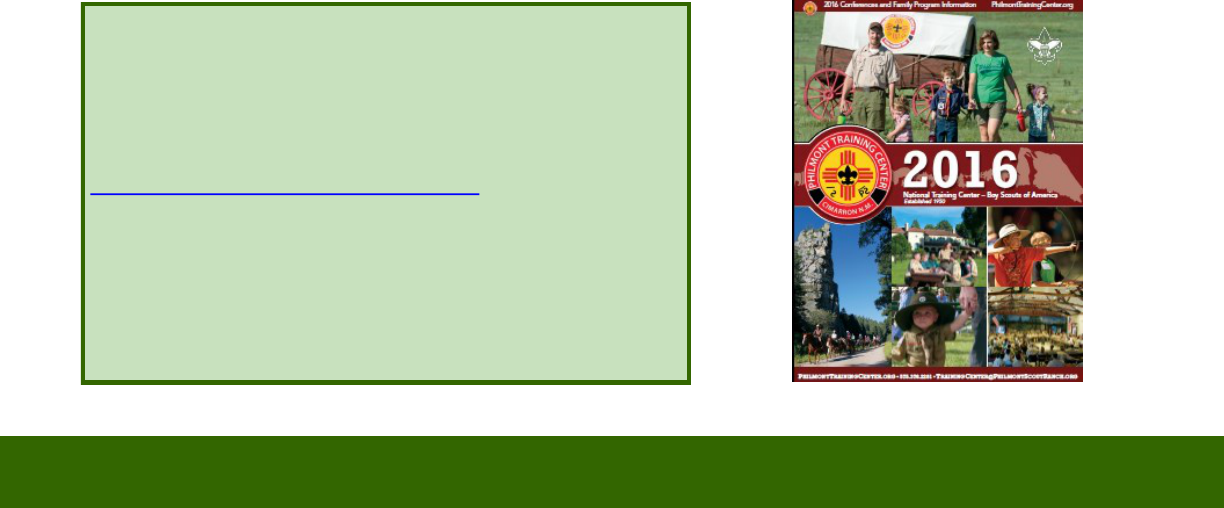
September-October 2015 Advancement News 11
From the Field
A Testimonial—Training Opportunities Make a Big Difference
“Aer serving as council advancement chair for two years, I decided to aend Philmont Training Center. I
parcipated in the Mechanics of Advancement conference, which led parcipants through the 2011 Guide
to Advancement.
“It was such a good experience that my husband and I headed back to Philmont the following year to aend
the Advancement Issues and Soluons conference. This conference was designed to analyze, discuss, and
solve real case studies similar to those faced by the Naonal Advancement Commiee. It was easy to relate
to many of the examples. Since the council in which I serve is one of the largest in the naon, just about eve-
rything you can imagine is seen—and more!
“What was really eye-opening was the Conference on Educaon for Advancement Administrators (CCEA),
held at the Florida Sea Base in January of 2014 and 2015. Parcipants were organized into teams, each given
the opportunity to preview and evaluate volunteer-designed and developed materials on topics from the
Guide to Advancement. Teams then iniated the development and update of new advancement resources to
help fellow Scouters present the advancement program as it is intended.
“When aending these conferences, I try to internalize what is taught, nong the changes that might help
my home council. Lots of thought and prayer goes into how to implement those changes. Then, once back
home, comes the work to make the improvements! These changes have helped strengthen the unity of our
council advancement commiee, which now works more as a team than ever before.
“You also can make Scoung beer in your council by comming to aend Philmont Training Center or
Florida Sea Base conferences in order to provide the best possible program for the youth in your care. To-
gether everyone can make a bigger dierence!”
Have you seen an impact on a boy or a young man or woman as a result of an experience in the advance-
ment program? Please send your story to advancement.team@scoung.org. Provide your name, email,
and general locaon so we may contact you if we have quesons. No guarantees, but you just might see
your story here.
Don’t Miss Out on These Great Training
Opportunities in 2016!
The Philmont Training Center schedule of conferences for
next summer is available now at
www.philmontscoutranch.org/PTC.aspx. Download a digital
copy of the 2016 conference brochure now, or visit your lo-
cal council service center for a copy. (Hint: If you cannot get
to the Mechanics of Advancement course at the Florida Sea
Base in January, check out the PTC’s schedule for the week
of June 12-18!)
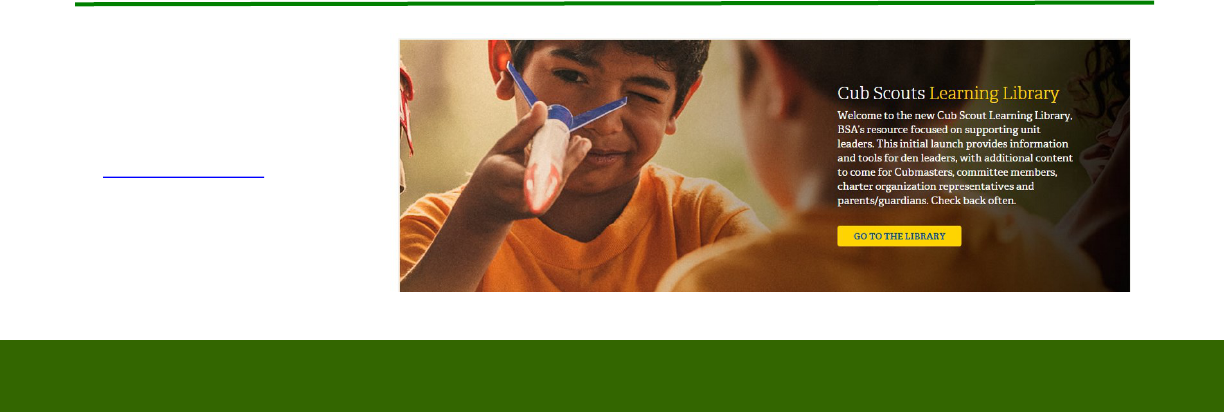
September-October 2015 Advancement News 12
From the Archives
Earlier in this edion, we were reminded that the new Cub Scout program includes many excing new ad-
ventures and many related advancement requirements, but one thing has not changed, even if the re-
quirements have—a boy’s personal adventure starts by making Bobcat. As pointed out in the following
arcle, this is precisely where the eorts of advancement commiees at every level should be focused if
that boy is to make Eagle Scout someday.
The Cub Scout Angle: The Inverted Percentage (October, 2011)
Many council and district advancement commiees spend most of their eorts on Boy Scout advance-
ment and especially Eagle Scout issues. This is understandable; the processes are involved. When consid-
ering the percentage of Cub Scout membership, however, we nd what some would call “the inverted
percentage”: The vast majority of the advancement commiee’s me is spent meeng the needs of a very
small percentage of our membership.
Each year, about 5 or 6 percent of Boy Scouts and Varsity Scout—less than 2 percent of the total tradion-
al membership of the BSA—earn Eagle Scout rank. However, Cub Scouts make up 60 percent of that total
tradional membership. It would make sense then, that 60 percent of advancement commiee eorts go
to building Cub Scoung advancement—or if not that level, then at least signicantly more than is now
spent. This would contribute enormously to the retenon of Cub Scouts, and since most Boy Scouts transi-
on from Cub Scoung, we should see more Boy Scouts, and eventually more Eagle Scouts.
There are a number of ways to address the inverted percentage and support Cub Scout advancement to
the degree it warrants. Here are just a few ideas.
Develop a clear understanding of “Unit Advancement Responsibilies,” secon 3.0.0.3 in the Guide to
Advancement. For Cub Scoung, the most important responsibility may be No. 2, “Educate parents,
guardians, unit leadership, and commiee members in ways to smulate and encourage advance-
ment.”
Iniate communicaon with Cub Scout packs, and develop relaonships with pack advancement coor-
dinators. Some of them may be candidates for the council or district advancement commiee, and
could lead the charge in helping packs fulll their responsibilies.
Keep Eagle issues in perspecve.
The Cub Scout
Learning Library
Check it out at
www.cubscouts.org.
Currently includes den
meeng plans for all required
and elecve adventures.

September-October 2015 Advancement News 13
Hear It First on Twitter
If you want the news rst, follow the Naonal Advancement Team on Twier. Topics cover the FAQs re-
ceived at the naonal oce, claricaons on policies and procedures, news on changes and new releases,
and best pracces in advancement.
If you already have a Twier account, follow us at @AdvBSA or BSA Advancement Team. If you do not, it is
me to take the plunge. Seng up an account is a quick and easy process at www.twier.com. To limit
incoming emails (‘tweets‘), you can select BSA Naonal Advancement Team as the only account you want
to follow.
Note: Advancement quesons should be directed to advancement.team@scoung.org.
Did You Receive these Tweets?
June 17 - Now posted: Eagle Scout Service Project Coach Applicaon, for oponal use by councils.
www.scoung.org/advancement
June 26—What counts as a "camping night" for the Camping merit badge?
blog.scoungmagazine.org/2015/06/24/ask-expert-isnt-camping-night-camping-mb/
July 1—Understanding the Scoutmaster conference: scoungmagazine.org/2014/12/understanding-
scoutmaster-conference/
July 3 - New 2016 Boy Scout requirements are now posted at www.scoung.org/programupdates.
July 7 - Just a reminder... Summer months count toward advancement me requirements.
blog.scoungmagazine.org/2014/07/31/one-scoutmaster-says-advancement-me-pauses-summer-bsa-says
July 17 - What if my Scout can't complete the First Class swim test? blog.scoungmagazine.org/2014/03/10/ask
-the-expert-what-if-my-scout-cant-compete-the-rst-class-swim-test/
August 15 - Tune into the August edion of Scoutcast to hear about the 2016 Boy Scout program updates:
www.scoung.org/Scoutcast/Scoutcast/2015.aspx
September 4 - Are you looking for den meeng plans for the new Cub Scout adventures? Check out the Cub
Scout Learning Library: hps://cubscouts.org
A Peek Ahead
Here is a glimpse of what we are working on for the next issue of Advancement News. As always, actual
content may vary somewhat based on a number of consideraons, especially to accommodate “late-
breaking news” of immediate importance to our subscribers.
Topics Planned for November-December
Opportunies for Advancement Administrators: Florida Sea Base—Mechanics of Advancement: January 10-16
From the Guide to Advancement: Secon 8: Boards of Review
The Cub Scout Angle: Cub Scout Learning Library

September-October 2015 Advancement News 14
Helpful Links
Here are some links to the most current materials of interest for Scouters who are involved in the ad-
ministraon of advancement. These and many more resources are available via the Advancement Re-
sources web page at www.scoung.org/advancement.
Advancement Educaonal Presentaons:
Cub Scout Advancement: Delivering Adventure
Geng the Most From Internet Advancement
• The Essenals of Merit Badge Counseling (English and Spanish)
• The Eagle Scout Service Project Coach (English and Spanish)
• Eecve Troop Advancement (English and Spanish)
• Including Scouts With Disabilies
Videocasts on Guide to Advancement, selected topics
Introducon to the Guide to Advancement
Judgment Calls
Boards of Review
Boards of Review Under Disputed Circumstances
Boards of Review Appeals
The Eagle Scout Applicaon Process
Eagle Scout Boards of Review
Videos
On Increasing Advancement
Why Advancement?
Guardian of the Gate
Guide to Advancement 2015
Eagle Scout Service Project Workbook
Navigating the Eagle Scout Service Project: Information for Project Beneficiaries
Eagle Scout Service Project Coach Application NEW!
Eagle Scout Rank Application
Merit Badge Counselor Information
Reporting Merit Badge Concerns
Venturing Summit Award Service Project Workbook
Venturing Board of Review Guide
Individual Scout Achievement Plan
Lone Scout Friend and Counselor Guidebook
